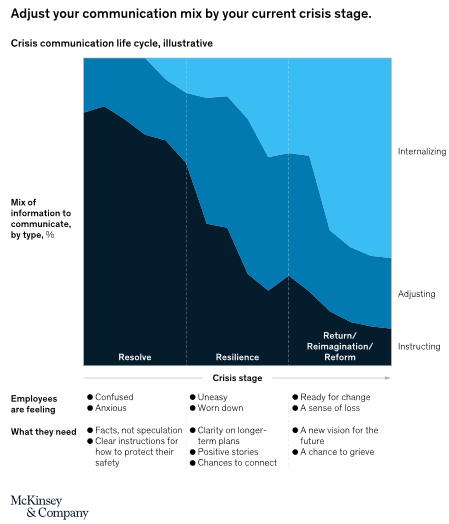COVID-19’s speed and scale breed uncertainty and emotional disruption. How organizations communicate about it can create clarity, build resilience, and catalyze positive change.
Crises come in different intensities. As a “landscape scale” event, 1 the coronavirus has created great uncertainty, elevated stress and anxiety, and prompted tunnel vision, in which people focus only on the present rather than toward the future. During such a crisis, when information is unavailable or inconsistent, and when people feel unsure about what they know (or anyone knows), behavioral science points to an increased human desire for transparency, guidance, and making sense out of what has happened.
At such times, a leader’s words and actions can help keep people safe, help them adjust and cope emotionally, and finally, help them put their experience into context—and draw meaning from it. But as this crisis leaps from life-and-death direction on public health and workplace safety to existential matters of business continuity, job loss, and radically different ways of working, an end point may not be apparent. While some may already be seeking meaning from the crisis and moving into the “next normal,” others, feeling rising uncertainty and worried about the future, may not yet be ready for hope.
COVID-19’s parallel unfolding crises present leaders with infinitely complicated challenges and no easy answers. Tough trade-offs abound, and with them, tough decisions about communicating complex issues to diverse audiences. Never have executives been put under such an intense spotlight by a skeptical public gauging the care, authenticity, and purpose that companies demonstrate. Leaders lack a clear playbook to quickly connect with rattled employees and communities about immediate matters of great importance, much less reassure them as they ponder the future.
Against this frenzied backdrop, it would be easy for leaders to reflexively plunge into the maelstrom of social-media misinformation, copy what others are doing, or seek big, one-off, bold gestures. It is also true that crises can produce great leaders and communicators, those whose words and actions comfort in the present, restore faith in the long term, and are remembered long after the crisis has been quelled.

So we counsel this: pause, take a breath. The good news is that the fundamental tools of effective communication still work. Define and point to long-term goals, listen to and understand your stakeholders, and create openings for dialogue. Be proactive. But don’t stop there. In this crisis leaders can draw on a wealth of research, precedent, and experience to build organizational resilience through an extended period of uncertainty, and even turn a crisis into a catalyst for positive change. Superior crisis communicators tend to do five things well:
- Give people what they need, when they need it. People’s information needs evolve in a crisis. So should a good communicator’s messaging. Different forms of information can help listeners to stay safe, cope mentally, and connect to a deeper sense of purpose and stability.
- Communicate clearly, simply, frequently. A crisis limits people’s capacity to absorb information in the early days. Focus on keeping listeners safe and healthy. Then repeat, repeat, repeat.
- Choose candor over charisma. Trust is never more important than in a crisis. Be honest about where things stand, don’t be afraid to show vulnerability, and maintain transparency to build loyalty and lead more effectively.
- Revitalize resilience. As the health crisis metastasizes into an economic crisis, accentuate the positive and strengthen communal bonds to restore confidence.
- Distill meaning from chaos. The crisis will end. Help people make sense of all that has happened. Establish a clear vision, or mantra, for how the organization and its people will emerge.
Give people what they need, when they need it
Every crisis has a life cycle, and emotional states and needs vary with the cycle’s stages. In a recent article, our colleagues framed the COVID-19 crisis in five stages: resolve, resilience, return, reimagination, and reform. These stages span the crisis of today to the next normal that will emerge after COVID-19 has been controlled. The duration of each stage may vary based on geographic and industry context, and organizations may find themselves operating in more than one stage simultaneously (exhibit).
MORE: https://www.mckinsey.com/Business%20Functions
About the authors: Ana Mendy is a partner in McKinsey’s Southern California office, Mary Lass Stewart is an expert in the Chicago office, and Kate VanAkin is an expert in the London office.